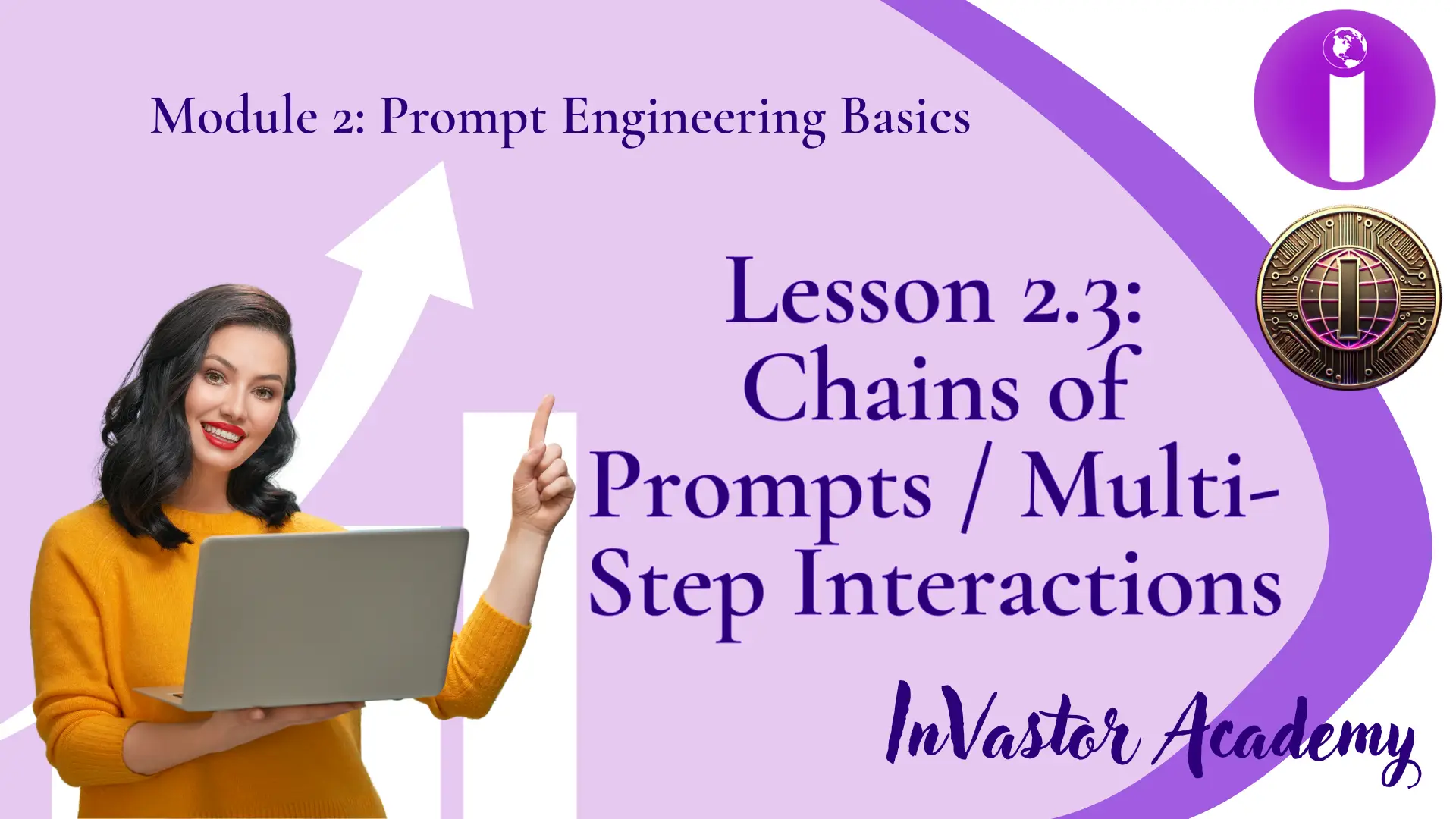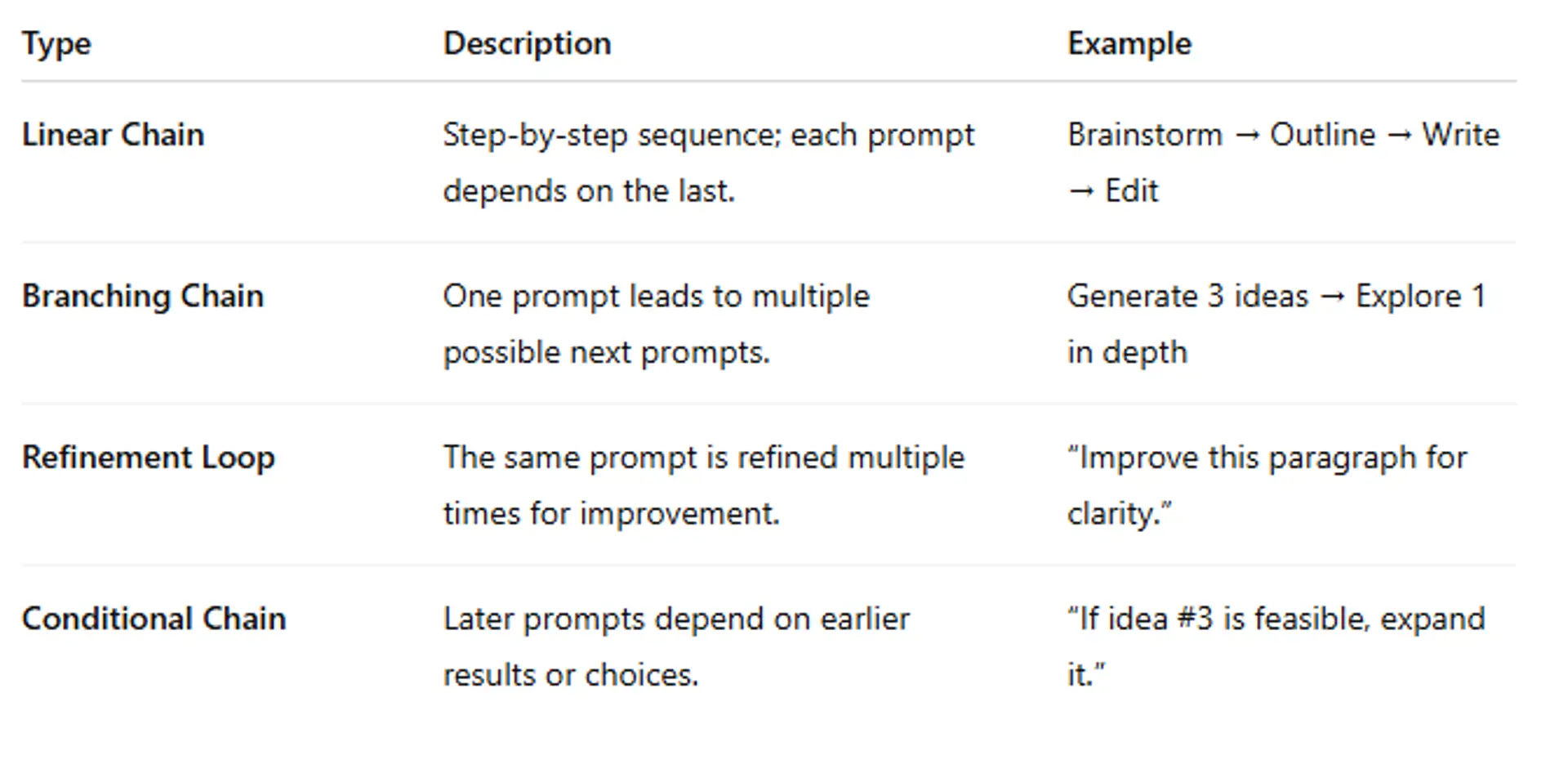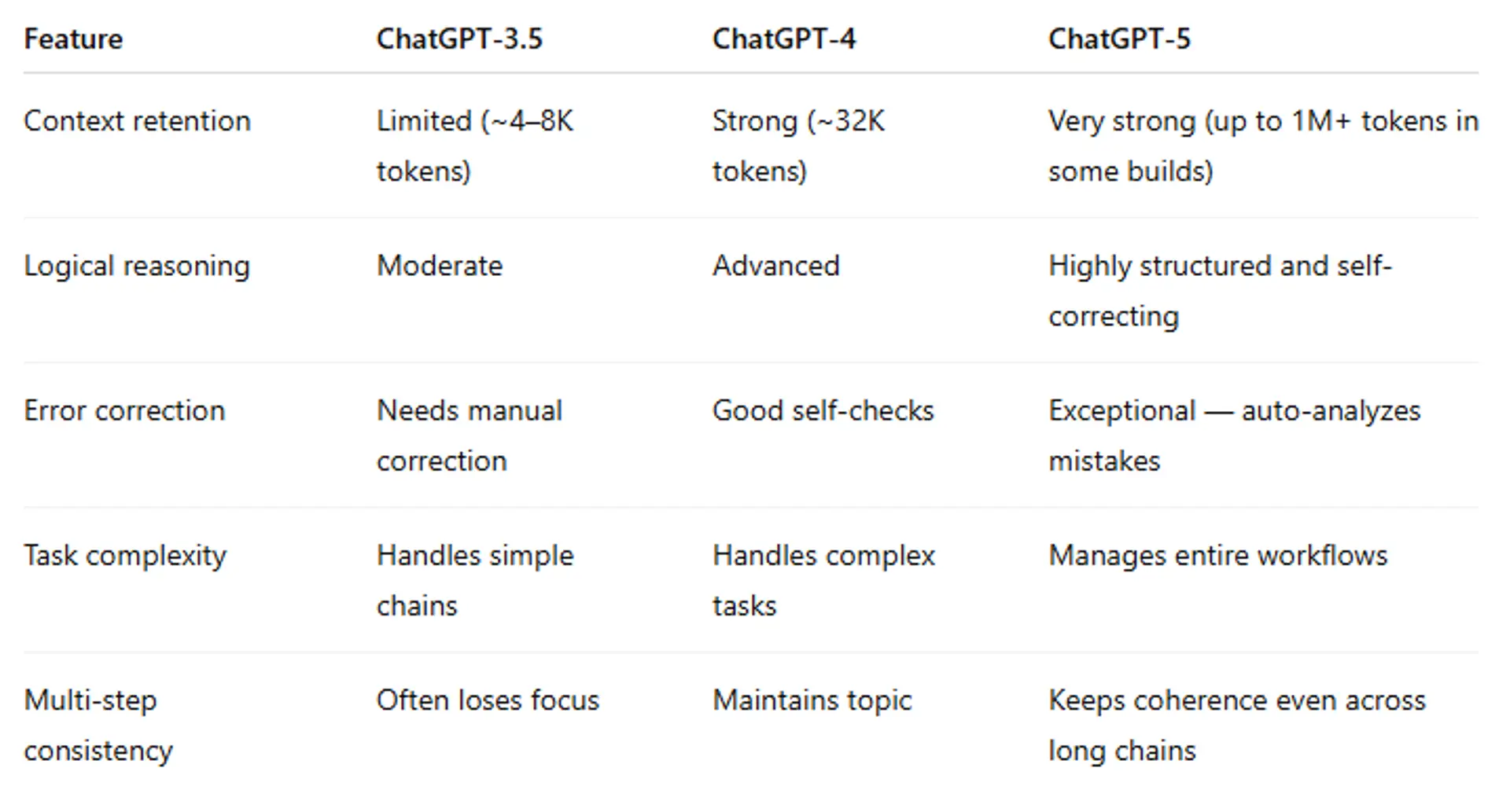

Module 2: Prompt Engineering Basics, Lesson 2.3 — Chains of Prompts / Multi-Step Interactions
Module 2: Prompt Engineering Basics
Lesson 2.3 — Chains of Prompts / Multi-Step Interactions
Lesson Objective
By the end of this lesson, you will be able to:
- Explain what a prompt chain is and why it’s essential for complex ChatGPT tasks.
- Design multi-step interactions to guide ChatGPT’s reasoning process.
- Compare how ChatGPT-3.5, 4, and 5 handle multi-step logic and memory.
- Create structured workflows using prompt chaining for research, writing, coding, or planning.
1. What Are Chains of Prompts?
A chain of prompts means breaking down a complex task into a sequence of smaller, connected prompts.
Instead of giving ChatGPT one long, confusing instruction, you guide it step by step — just like teaching a student.
Example:
❌ Single, overloaded prompt:
“Write a business plan for a café, including market analysis, marketing strategy, budget, and risks.”
✅ Prompt chain:
- “List five things to consider before starting a café.”
- “Create a target market analysis for the café.”
- “Write a marketing strategy based on that analysis.”
- “Estimate a basic budget and potential risks.”
Each step builds on the previous one — producing deeper, more logical results.
2. Why Prompt Chaining Works
ChatGPT is strongest when it reasons incrementally.
Each answer it gives creates a “context memory” that it builds on.
By chaining prompts, you:
- Reduce confusion by tackling one idea at a time.
- Improve accuracy — fewer hallucinations or skipped steps.
- Gain flexibility — you can refine one stage without restarting.
- Mimic human logic — like outlining, drafting, and editing.
💬 Analogy:
Prompt chaining is like teaching a student to write an essay — you don’t say “Write the whole essay now.”
You say, “Start with the outline → write the intro → build the arguments → conclude.”
3.Types of Multi-Step Interactions

💡 Pro Tip: You can mix and match chain types for flexible, iterative workflows.
4.Real-World Examples of Prompt Chaining
🧑🏫 Teaching / Education
Step 1: “List key concepts in photosynthesis.”
Step 2: “Explain each concept in simple terms for a 10-year-old.”
Step 3: “Create a 5-question quiz to test understanding.”
👩💻 Coding
Step 1: “Plan a Python program that tracks expenses.”
Step 2: “Write the code for step 1.”
Step 3: “Debug and explain any issues in the code.”
🧾 Business Planning
Step 1: “Brainstorm 3 business ideas in eco-friendly fashion.”
Step 2: “Do a quick SWOT analysis for the best idea.”
Step 3: “Create a 6-month marketing plan for that business.”
✍️ Writing / Content Creation
Step 1: “Outline a blog post about the future of AI.”
Step 2: “Write the introduction.”
Step 3: “Write the body using data from step 1.”
Step 4: “Add a conclusion and call-to-action.”
5.How ChatGPT-3.5, 4, and 5 Handle Multi-Step Logic

💬 Tip:
If you’re using GPT-3.5, summarize the output of each step manually.
With GPT-4 or 5, you can simply say:
“Using everything we discussed so far, proceed to the next step.”
6.How to Build a Multi-Step Chain
Step 1️⃣ — Define the End Goal
“I want to create an online course outline about AI basics.”
Step 2️⃣ — Break It into Logical Steps
- “List main topics in AI basics.”
- “Create 3 subtopics for each main topic.”
- “Suggest key learning objectives for each subtopic.”
Step 3️⃣ — Give Instructions at Each Step
At each stage, ask for a specific, limited output (lists, summaries, tables).
Step 4️⃣ — Connect the Steps
Reference the previous response:
“Using the topics you just listed, create subtopics.”
Step 5️⃣ — Refine and Summarize
At the end, ask ChatGPT to merge all steps into one cohesive output:
“Combine everything we’ve created into a final course outline.”
7. Sample Prompt Chain Exercise
Goal: Write a short research summary on “The Impact of AI on Healthcare.”
- “List five ways AI is transforming healthcare.”
- “Choose one area from your list and explain it in 150 words.”
- “Find potential challenges with that application.”
- “Suggest future improvements or innovations.”
- “Summarize everything into a 200-word mini report.”
✅ Result: A clear, structured, well-reasoned essay — created collaboratively with ChatGPT.
8. Learn More with the Videos Below
They can learn additional concepts with the videos below:
🎥 How to Chain Prompts for Complex Tasks (Prompt Engineering Guide)
🎥 Building Multi-Step Workflows with ChatGPT
🎥 Reasoning in Steps: How to Get Smarter Responses from ChatGPT
Lesson Quiz 2.3
Please complete this quiz to check your understanding of the lesson. You must score at least 70% to pass this lesson quiz. This quiz counts toward your final certification progress.
Answer the quiz using the Google Form below.
Conclusion
Chaining prompts is the key to turning ChatGPT into a true thinking partner.
By designing a structured conversation — step by step — you create more accurate, personalized, and reusable outputs.
This technique also helps ChatGPT-5 excel at multi-layered reasoning, from lesson planning to software development.
In the next lesson, 2.4 — Avoiding Pitfalls & Common Mistakes, we’ll look at how to recognize weak prompts, prevent hallucinations, and troubleshoot common errors in ChatGPT interactions.
Previous and Next Lessons:
Module 2: Prompt Engineering Basics, Lesson 2.1 — Anatomy of a Good Prompt
Module 2: Prompt Engineering Basics, Lesson 2.4 — Avoiding Pitfalls & Common Mistakes
Related Posts
© 2025 Invastor. All Rights Reserved

User Comments